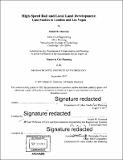| dc.contributor.advisor | Joseph M. Sussman. | en_US |
| dc.contributor.author | Mascoop, Daniel R | en_US |
| dc.contributor.other | Massachusetts Institute of Technology. Department of Urban Studies and Planning. | en_US |
| dc.coverage.spatial | e-uk-en n-us-nv | en_US |
| dc.date.accessioned | 2018-02-16T20:06:37Z | |
| dc.date.available | 2018-02-16T20:06:37Z | |
| dc.date.copyright | 2017 | en_US |
| dc.date.issued | 2017 | en_US |
| dc.identifier.uri | http://hdl.handle.net/1721.1/113807 | |
| dc.description | Thesis: M.C.P., Massachusetts Institute of Technology, Department of Urban Studies and Planning, 2017. | en_US |
| dc.description | Page 142 blank. Cataloged from PDF version of thesis. | en_US |
| dc.description | Includes bibliographical references (pages 141-151). | en_US |
| dc.description.abstract | This thesis explores the relationship between high-speed rail development, local rail station development and land development. The efficacy of a high-speed rail system depends, in part, upon rail stations' locations close to urban centers and integration into the broader transportation networks and urban realm. Through economies of agglomeration, high-speed rail can bring wider economic benefits to regions, cities and local areas. Transit-oriented development can be used as a strategy to capture these local-level benefits and also bring urban development to the highspeed rail system. In order to evaluate these relationships, this thesis examines two case studies. In the United Kingdom, the government chose St. Pancras Station as the London terminus for High-Speed 1, the first high-speed rail route in the UK. Although protected under historic landmark status, St. Pancras Station had been neglected for decades and required an E800 million refurbishment. This project also opened up new land, which currently is being developed as part of the 3 billion mixed-use project. Property values in the vicinity of the station have increased significantly, and this project has garnered wide acclaim for its architectural and place-making achievements. XpressWest, a private high-speed rail developer founded in 2005, is proposing to build and operate a high-speed rail line between Victorville, California, and Las Vegas, Nevada. XpressWest plans to compete mainly with driving, since this is the most common mode of transportation on this corridor. A benefit-cost analysis shows that the project likely will have net negative impacts when considering only transportation benefits, such as time-savings. Wider economic benefits, however, could be on the order of billions of dollars, and have the potential to exceed the project's costs. In conducting stakeholder analyses and in comparing these two case studies, this thesis determines that high-speed rail systems have the potential to generate a variety of local social and economic benefits, which are valued differently by different stakeholders. Through collaboration, these stakeholders may ensure that these local benefits are maximized. As long as these benefits hold value to the relevant stakeholders, there may be opportunities for local benefits to exceed the costs of infrastructure development. | en_US |
| dc.description.statementofresponsibility | by Daniel R. Mascoop. | en_US |
| dc.format.extent | 186 pages | en_US |
| dc.language.iso | eng | en_US |
| dc.publisher | Massachusetts Institute of Technology | en_US |
| dc.rights | MIT theses are protected by copyright. They may be viewed, downloaded, or printed from this source but further reproduction or distribution in any format is prohibited without written permission. | en_US |
| dc.rights.uri | http://dspace.mit.edu/handle/1721.1/7582 | en_US |
| dc.subject | Urban Studies and Planning. | en_US |
| dc.title | High-speed rail and local land development : case studies in London and Las Vegas | en_US |
| dc.type | Thesis | en_US |
| dc.description.degree | M.C.P. | en_US |
| dc.contributor.department | Massachusetts Institute of Technology. Department of Urban Studies and Planning | |
| dc.identifier.oclc | 1022949371 | en_US |
